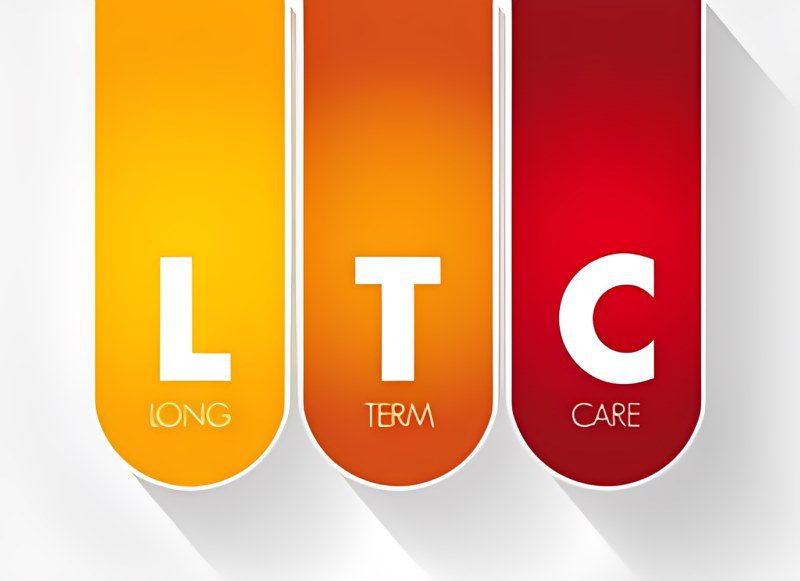Long-term care involves a variety of services for people who need assistance due to a prolonged illness, disability, or cognitive disorder. Over 70% of adults turning age 65 can expect to need some type of long-term care services in their lifetime, whether at home or in a facility. The costs associated with long-term care can be substantial, with national averages for home health aides over $50,000 per year and nursing homes over $90,000 per year.
LTC insurance is specifically designed to help cover these long-term care costs. The main goal of long-term care insurance is to protect your assets and income sources like retirement savings in the event you require extended care. Policies will pay out a daily cash benefit to be used towards costs like in-home nurses, assisted living facilities, adult day services, respite care, and more. If you have substantial assets you want to protect or don’t want to rely on family support; you may want to consider purchasing a long-term care insurance policy.
What Does Long-term Care Insurance Cover?
Coverage for In-Home and Nursing Home Care
Long-term care insurance policies cover care received in your home from visiting nurses, home health aides, physical therapists, and more. Policies also cover care provided in nursing homes, assisted living facilities, and other specialized care facilities when needed. Most long-term care insurance plans allow you to receive care in a variety of settings rather than restricting where benefits can be used.
Who needs long-term care (LTC) insurance?
Anyone with substantial assets they want to preserve for their heirs rather than spend on care costs should consider a policy. Middle-income seniors facing gaps in government and health insurance coverage can also benefit.
Different Types of Facilities and Services Covered
Long-term care insurance covers care provided in facilities ranging from small family-style homes to large skilled nursing facilities. Assisted living, memory care, and hospice facilities are also included. In addition to room and board, the insurance covers services required for your treatment plans, like skilled nursing, physical or occupational therapy, speech therapy, medication management, and more. Make sure your long-term care insurance policy covers the necessary facility types and services for your needs.

Daily Benefit Amounts and Duration of Coverage
Long-term care insurance policies pay out a daily cash benefit covering facility fees and service costs. Most policies have options ranging from $100 to $400+ per day, depending on your budget and area long-term care costs. Many policies provide benefits for 2-5 years, but lifetime coverage or shorter durations may also be available. Considering your financial situation and projected future care costs in your locale is essential when selecting an appropriate daily benefit amount and duration for your long-term care insurance coverage.
Additional Benefits like Respite Care, Care Coordination
Besides direct care coverage, many long-term care insurance plans include extra benefits like respite care to provide family caregivers temporary relief, home modification allowances to install things like wheelchair ramps, and care coordination services to help manage treatment and medications. These additional long-term care insurance benefits provide support services that can be invaluable for those recovering at home and transitioning facilities.
Long-term Care Insurance Costs and Premiums
Main Factors Affecting Long-Term Care Insurance Costs
Several key factors impact what you’ll pay in premiums for long-term care insurance coverage. These include your age at the time of purchase, your health status, the maximum daily benefit amount you select, and the duration of benefits or policy length you choose. Insurers also price based on additional benefits and features, plus whether coverage adjusts for inflation. Considering these factors helps long-term care insurance shoppers evaluate costs and value.
Estimated Premium Costs by Age and Maximum Daily Benefit
Long-term care insurance premiums increase drastically with the policyholder’s age when coverage starts. For example, a 55-year-old may pay $2,500 annually for a policy with a $200 daily maximum benefit while someone age 75 may spend over $10,000 per year for the same coverage. Comparing quotes and coverage terms across insurers can uncover large price variances. Consulting an independent long-term care insurance agent provides an expert perspective when evaluating premium costs.
Options to Modify Coverage and Premiums to Fit Your Budget
The wide range of long-term care insurance options allows tailoring policies to fit different budgets and needs. Choices like lowering the maximum daily benefit or benefit period, adding a waiting period before coverage kicks in, excluding certain conditions, or taking a smaller inflation adjustment can reduce annual premiums, often substantially. Being flexible and open to modifying coverage terms unlocks affordable long-term care insurance for middle-income seniors who still want solid financial protection.
Is Long-term Care Insurance Worth It?
Protecting Your Assets and Leaving Inheritance for Family
A major benefit of long-term care insurance is protecting assets so they can be preserved for your children and heirs rather than depleted on care costs. Policies pay cash benefits that cover portions of long-term care expenses ranging from home health aides to nursing homes, allowing you to save personal assets. This leaves an inheritance for loved ones and avoids burdening family members with supporting care costs. For affluent seniors, long-term care insurance is often worth the premium investment.
Covering Gaps Left by Medicare and Other Health Insurance
Government health programs like Medicare provide little long-term care support, and gaps in supplemental policies mean out-of-pocket liability. Long-term care insurance steps in to cover deductibles, co-pays, and excluded services, plus provides cash to cover room and board, which no health insurance reimburses. For middle-income seniors, long-term care insurance can provide complete coverage and financial security not otherwise available.
How much does long term care insurance cost?
Premiums vary greatly based on your age when coverage starts and the maximum daily benefit amount selected. A 55-year-old may pay $2,500 annually for $200 per day, while someone age 75 may pay over $10,000 annually for the same benefit.
What is covered under long-term care insurance?
Policies cover care ranging from at-home nursing and aides to assisted living facilities to nursing homes. Daily cash benefits apply towards the fees for room, board, nursing, aides, therapies, and other required services. Additional support benefits may include respite care, home modifications, and care coordination.
When You Should Consider Skipping Long-Term Care Insurance
If you have very limited assets or income streams like Social Security sufficient to cover projected care costs, the premium investment may not justify long-term care insurance coverage. Low-income individuals who qualify for Medicaid can receive public assistance for long-term care expenses after spending down personal funds first. For those of modest means, relying on state and federal programs may be the best approach rather than paying for long-term care insurance policies.

How to Choose the Best Long-term Care Insurance Policy
Key Factors to Compare Between Long Term Care Insurance Options
When evaluating long-term care insurance policies, key aspects to compare include:
- The maximum daily benefit amount.
- Duration of coverage.
- Types of facilities and services covered.
- The financial stability of the insurance company.
- Premium costs.
Also, confirm the policy covers care appropriate for your particular situation, like Alzheimer’s or home health care. Meeting with a certified expert guides in identifying the most suitable long-term care insurance policy for your needs and budget.
When can I start using my long-term care insurance benefits?
Most policies have an elimination or waiting period between 0 to 100 days from when coverage is approved until you can access benefits, so no immediate claims. Pre-existing condition exclusions also apply from 6-12 months typically.
Understanding Exclusions, Waiting Periods, and Inflation Protection
Reading the fine print is imperative when selecting long-term care insurance, as policies contain:
- Exclusions.
- Waiting periods before accessing benefits.
- Clauses for dropping coverage or premium hikes.
Look for inflation protection to help benefits keep pace with rising future health costs. Requiring full disclosure and explanations for confusing legal terminology protects against unintended gaps in your long-term care insurance coverage.
Tax Incentives and Partnerships to Reduce Premium Costs
Various long-term care insurance tax incentives and coverage partnerships that reduce out-of-pocket premiums are worth exploring. These include health savings accounts, claiming medical expense deductions, life/long-term care hybrid policies, and state/federal program collaborations. For example, New York’s partnership policies mean you can shelter assets equal to the insurance payout before Medicaid begins paying. Discussing circumstances with a knowledgeable guide can uncover savings opportunities.
Conclusion: Plan for Long-term Care Needs
As medical advances continue extending lifespans, the need for long-term supportive services increases. Over the next 30 years, the senior population over 85, which utilizes the highest levels of long-term care, will nearly triple. With growing demand, ongoing staffing shortages, and rising wages, the costs of services from skilled nursing facilities to home health aides are projected to keep significantly outpacing inflation.
Planning for these substantial and escalating long-term care costs is imperative. For those with assets to protect and inherit, as well as middle-income seniors facing coverage gaps, long-term care insurance can provide valuable financial safeguards. With abundant policy options available, working with an independent, certified expert to objectively evaluate your situation and risk exposures streamlines identifying the optimal solutions. Only through proper analysis and consultation can you secure tailored long-term care insurance coverage that cost-effectively prepares you for the realities of aging.
Can I deduct long-term care insurance premiums on my taxes?
Yes, portions of long-term care insurance premiums as well as eligible care costs can count towards your medical expense deductions once medical costs exceed 7.5% of adjusted gross income. Various other tax incentives exist.

